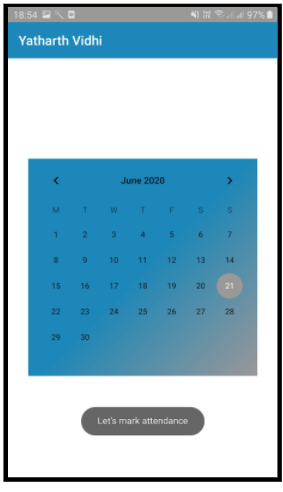The main motive of the project is to develop an attendance application which will take the attendance of the students by recognizing their face and fingerprint ( biometric). It will save the time taken and efforts made by the professor in taking manual attendance. With this attendance app, students will not be able to mark proxies for others.
-
Yatharth Vidhi is an attendance application. It will be installed in the professor's mobile who is taking the attendance. Students’ data will be already trained in the application and the mobile will be passed among the students for scanning their faces in the camera. If it matches with the trained data, then attendance will be marked present.
-
- When we open our app, we get the login page. After this:
- If you are a member, add your credentials.
- If you are not a member, click Register.
- After login, we get to our main page, which has two options:
- Attendance: After this, we get a calendar to choose the date for marking attendance.
- 02.Train data: After this, we get a list of subjects that have been registered under the professor’s name. The add button (circle at the button right corner), is used to add subjects under the professor’s name.
- After clicking the train icon and being directed to the list of subjects page, we click on a particular subject for saving the students credential. Then we are taken to the camera and after that, we train the data for face recognition of the students that are enrolled in that particular subject. After training, you can go to the main page and start taking attendance!!
- After clicking on the attendance icon, we first have a calendar page and then a page with the date and list of subjects that are registered under the professor’s name. Then after clicking on a particular subject, we are taken to the camera and further xafter recognition of the face, a popup appears with attendance marked successfully.








-
The main part of the application was to develop the face recognition algorithm. For
the face recognition under variation in lighting and facial expression, we have 4
different types of algorithms available given as:
- Correlation
- A variant of the linear subspace method
- Eigenface method
- Fisherface method Among these we have used the Eigenface method in our application( we implemented fisherface and eigenface methods but went forward with the eigenface method.)
As other methods are computationally expensive and require great amounts of storage, it is natural to pursue dimensionality reduction schemes. A technique now commonly used for dimensionality reduction in computer vision—particularly in face recognition—is principal components analysis (PCA). The Eigenface method is based on linearly projecting the image space to a low dimensional feature space. However, the Eigenface method, which uses principal components analysis (PCA) for dimensionality reduction, yields projection directions that maximize the total scatter across all classes, i.e., across all images of all faces. In choosing the projection which maximizes total scatter, PCA retains unwanted variations due to lighting and facial expression.